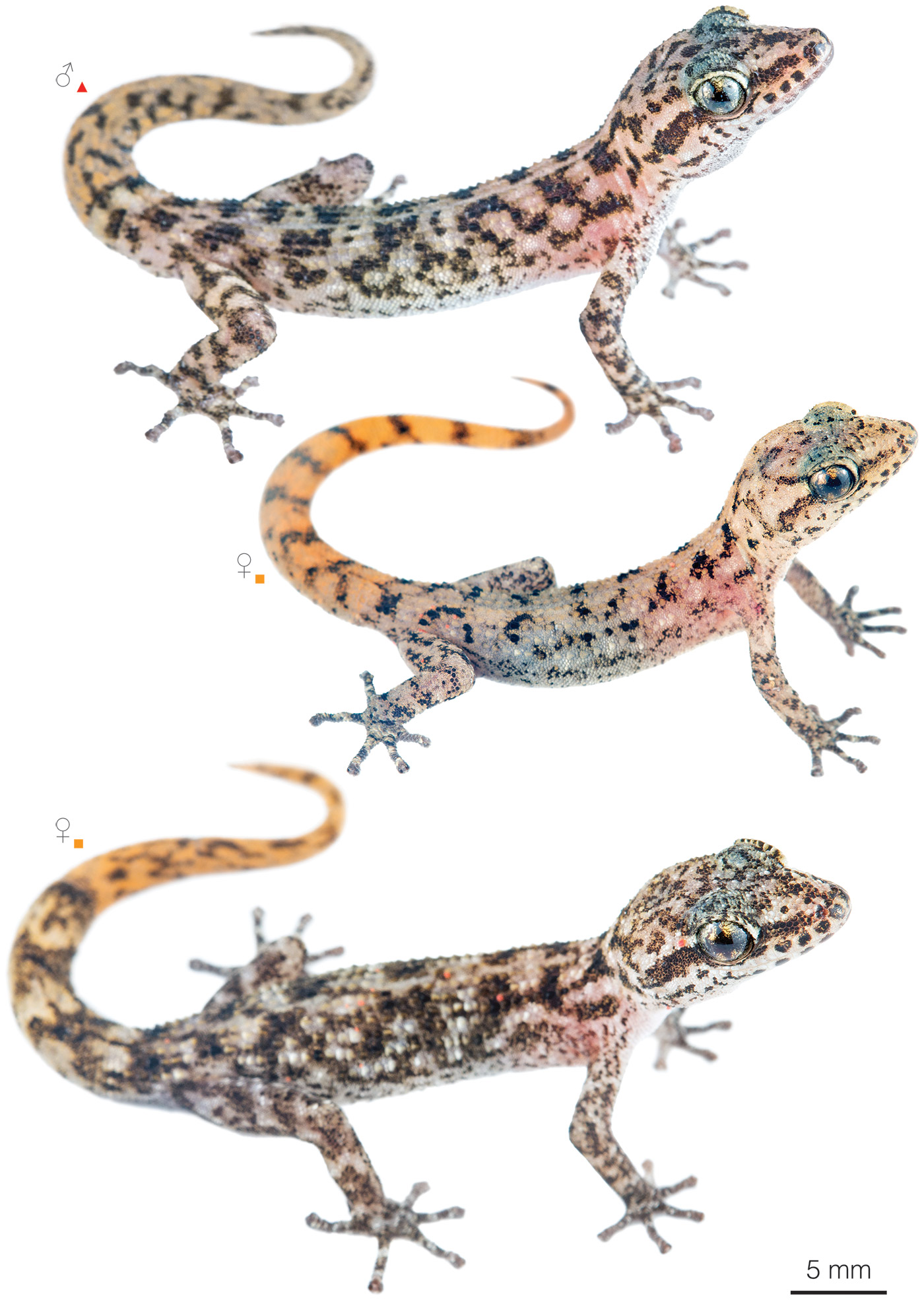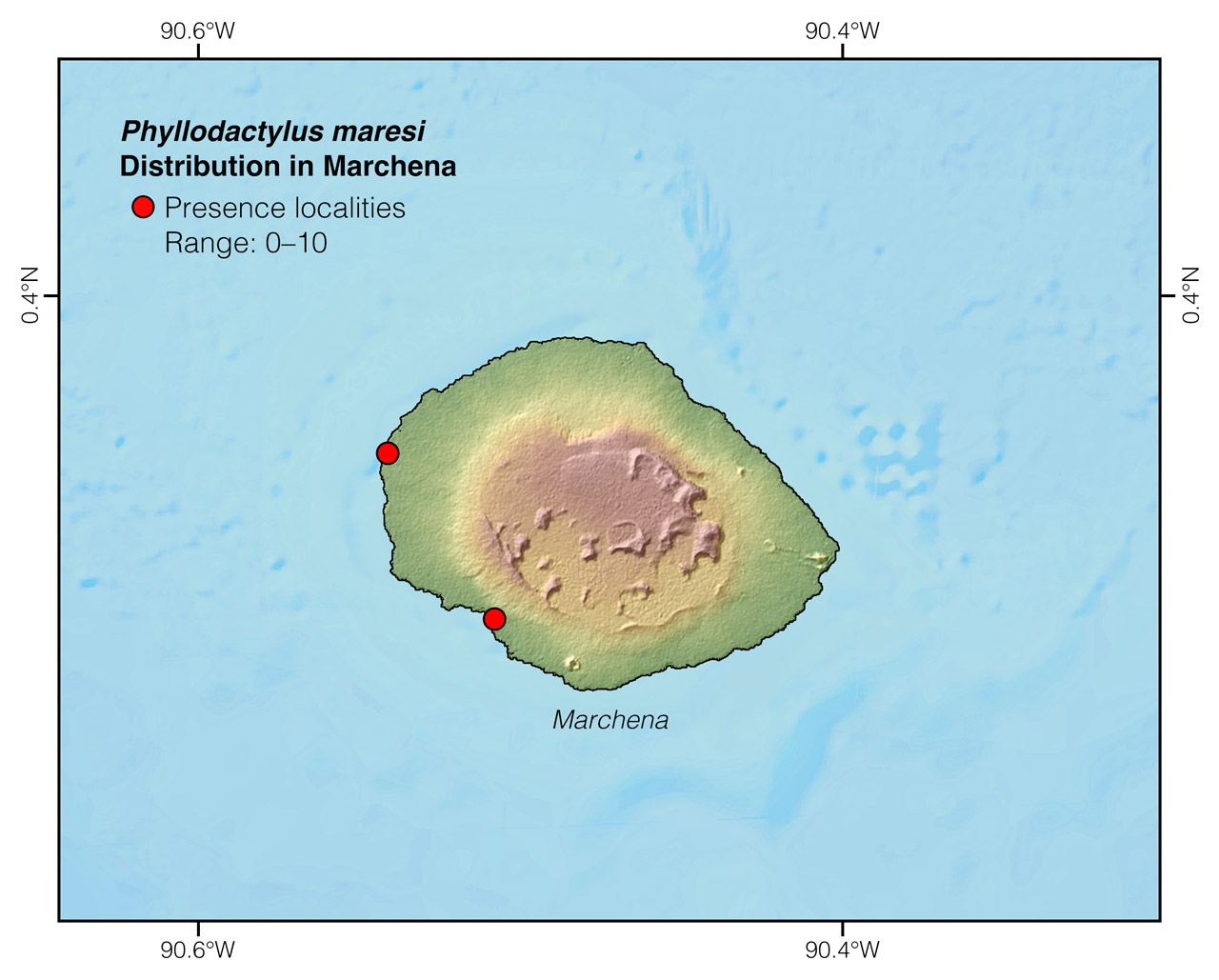Published October 10, 2019. Updated December 31, 2023. Open access. Peer-reviewed. | Purchase book ❯ |
Mares Leaf-toed Gecko (Phyllodactylus maresi)
Reptiles of Ecuador | Sauria | Phyllodactylidae | Phyllodactylus maresi
English common name: Mares Leaf-toed Gecko.
Spanish common names: Geco de Mares, salamanquesa de Mares.
Recognition: ♂♂ 7.6 cmMaximum distance from the snout to the tip of the tail. ♀♀ 9.1 cmMaximum distance from the snout to the tip of the tail..1 Phyllodactylus maresi is easily distinguishable from other native saurians occurring on Santiago and Marchena islands (that is, iguanas and lava lizards) by its nocturnal habits, vertical pupils, and fingertips lacking visible claws.1 No other gecko has been recorded on the islands where P. maresi occurs. The dorsal coloration is usually pale gray with contrasting irregular black blotches (Fig. 1).1

Figure 1: Individuals of Phyllodactylus maresi from Galápagos: Punta Mejía, Marchena Island (); Puerto Egas, Santiago Island ().
Natural history: Phyllodactylus maresi is a nocturnal and primarily terrestrial gecko that inhabits seasonally dry forests, dry shrublands, and dry grasslands where it forages at ground level or on rocks, leaf-litter, and trunks of trees up to 2 m above the ground.1 During the daytime, Mares Leaf-toed Geckos have been found under the bark of trees, under rocks, and inside rotten logs.1,2 When threatened, these shy and wary lizards flee into crevices. If captured, they may shed the tail. There are recorded instances of predation on members of this species by snakes (Pseudalsophis thomasi).3 Eggs of P. maresi have been found in crevices of an abandoned house in Santiago Island.1
Conservation: Near Threatened Not currently at risk of extinction, but requires some level of management to maintain healthy populations..1 Phyllodactylus maresi is listed in this category because the species does not seem to be facing major immediate threats of extinction. The islands where P. maresi occurs are not populated by humans or major introduced lizard predators (such as cats) and all of these islands are protected within the Galápagos National Park.1 However, in Santiago Island, P. maresi is facing the threat of predation by introduced black rats.1
Distribution: Phyllodactylus maresi is endemic to an area of approximately 226 km2 on four islands (Bartolomé, Marchena, Santiago, and Rábida) and Mares Islet in Galápagos, Ecuador (Figs 2–4), Galápagos, Ecuador.

Figure 2: Distribution of Phyllodactylus maresi in Galápagos. The star corresponds to the type locality: Mares Islet. See Appendix 1 for a complete list of the presence localities included in the map.

Figure 3: Distribution of Phyllodactylus maresi in Santiago Island. The star corresponds to the type locality: Mares Islet. See Appendix 1 for a complete list of the presence localities included in the map.

Figure 4: Distribution of Phyllodactylus maresi in Marchena Island. See Appendix 1 for a complete list of the presence localities included in the map.
Etymology: The generic name Phyllodactylus comes from the Greek words phyllon (=leaf) and daktylos (=finger),4 and refers to the leaf-shaped fingers characteristic of this group of geckos. The specific epithet maresi honors Lodovico Mares, an Italian businessman and Maecenas who funded the expedition that led to the discovery of P. maresi on the islet now known as Mares.1
See it in the wild: Since it is a nocturnal species, Phyllodactylus maresi is unlikely to be seen during touristic day trips to Santiago Island. Researchers and members of the Galápagos National Park may visit the habitat of the Mares Leaf-toed Gecko, but only in the context of a scientific expedition or a conservation agenda.
Author: Alejandro ArteagaaAffiliation: Fundación Khamai, Reserva Arlequín, Ecoruta Paseo del Quinde km 56, Santa Rosa de Mindo, Pichincha 171202, Ecuador.
Academic reviewers: Miguel Vences,bAffiliation: Technische Universität Braunschweig, Braunschweig, Germany. Alex Pyron,cAffiliation: George Washington University, Washington, D.C., USA. and Claudia KochdAffiliation: Zoologisches Forschungsmuseum Alexander Koenig, Bonn, Germany.
Photographer: Jose VieiraeAffiliation: Tropical Herping (TH), Quito, Ecuador.,fAffiliation: ExSitu, Quito, Ecuador.
How to cite? Arteaga A (2023) Mares Leaf-toed Gecko (Phyllodactylus maresi). In: Arteaga A, Bustamante L, Vieira J (Eds) Reptiles of Ecuador: Life in the middle of the world. Available from: www.reptilesofecuador.com. DOI: 10.47051/WZEG7091
Literature cited:
- Arteaga A, Bustamante L, Vieira J, Tapia W, Carrión J, Guayasamin JM (2019) Two new species of leaf-toed geckos (Phyllodactylus) from Isabela Island, Galápagos Archipelago, Ecuador. In: Arteaga A, Bustamante L, Vieira J, Tapia W, Guayasamin JM (Eds) Reptiles of the Galápagos: Life on the Enchanted Islands. Tropical Herping, Quito, 174–187.
- Van Denburgh J (1912) Expedition of the California Academy of Sciences to the Galápagos Islands, 1905-1906. VI. The geckos of the Galápagos Archipelago. Proceedings of the California Academy of Sciences 1: 405–430.
- Ortiz-Catedral L, Christian E, Skirrow MJA, Rueda D, Sevilla C, Kumar K, Reyes EMR, Daltry JC (2019) Diet of six species of Galapagos terrestrial snakes (Pseudalsophis spp.) inferred from faecal samples. Herpetology Notes 12: 701–704.
- Brown RW (1956) Composition of scientific words. Smithsonian Books, Washington, 882 pp.
Appendix 1: Locality data used to create the distribution map of Phyllodactylus maresi in Ecuador (Fig. 2). Go to the section on symbols and abbreviations for a list of acronyms used. Asterisk (*) indicates type locality.
| Country | Province | Locality | Source |
| Ecuador | Galápagos | Bartolomé Island | Torres-Carvajal et al. 2011 |
| Ecuador | Galápagos | Bartolomé, 5 km NW of | Lotti et al. 2012 |
| Ecuador | Galápagos | Islote Mares* | Lanza 1973 |
| Ecuador | Galápagos | James Bay | Arteaga et al. 2019 |
| Ecuador | Galápagos | Lava ridge at James Bay | Arteaga et al. 2019 |
| Ecuador | Galápagos | Playa Dorada (in Santiago) | Arteaga et al. 2019 |
| Ecuador | Galápagos | Playa Negra (=Playa del Muerto) | Arteaga et al. 2019 |
| Ecuador | Galápagos | Puerto Egás | Arteaga et al. 2019 |
| Ecuador | Galápagos | Punta Mejía | Arteaga et al. 2019 |
| Ecuador | Galápagos | Rábida | Arteaga et al. 2019 |
| Ecuador | Galápagos | Santiago Island, northern shore | Arteaga et al. 2019 |